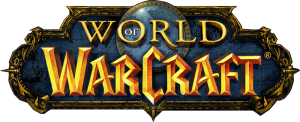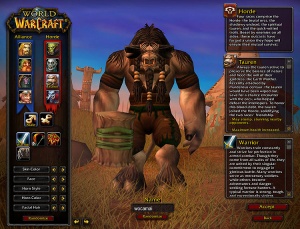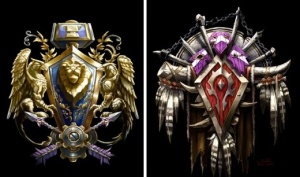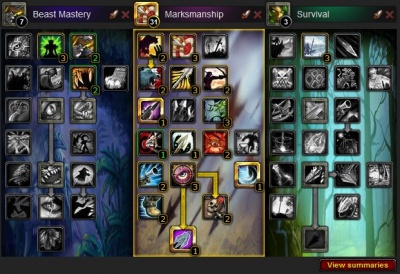World of Warcraft
World of Warcraft (WoW) is a massively multiplayer online role-playing game (MMORPG) produced by Blizzard Entertainment, based in Irvine, California. It is the fourth game set in the Warcraft Universe that was originally conceived in 1994 with Blizzard’s release of Warcraft: Orcs & Humans. The game takes place in a virtual fantasy world called Azeroth and an extradimensional realm called Outland. The game’s storyline is set four years after the conclusion of Blizzard’s previous Warcraft series release, Warcraft III: The Frozen Throne. World of Warcraft was announced on September 2, 2001 and was released on November 23, 2004.
There are three expansions that impacted the gameplay and storyline in significant ways, and an upcoming expansion that is expected to have a similar effect. The first, The Burning Crusade, was released on January 16, 2007. Wrath of the Lich King, the second expansion, was released on November 13, 2010. The most recent expansion, Cataclysm, was released on December 7, 2010. In October 2011 at Blizzcon, a fourth expansion, Mists of Pandaria, was announced along with some of the content to be expected in the expansion [1].
World of Warcraft is the most popular MMORPG to date, with approximately 11 million subscribers as of June, 2011.
Contents
Gameplay
Choosing a realm
Before a character avatar is created, the player must select a realm to play on. Players can create multiple characters on all realms, but are restricted to 10 characters per realm and a maximum of 50 characters. Available realm types are player versus player (PVP), player versus enemies (PVE), player versus enemies normal roleplaying (PVE-RP), or player versus player roleplaying (PVP-RP). Player versus player realms are geared towards players who enjoy engaging players of the opposite faction in combat with each other freely throughout the virtual world. Player versus enemies realms only allow cross-faction combat in battlegrounds, arena battles, and special PvP zones. In both realm types, player versus player combat with other players of the same faction is only accessible through dueling. Realms are categorized by language.
Creating a character
In World of Warcraft, players create and control a character avatar within the virtual world Azeroth. The virtual world offers the player many gameplay options, most of which involve exploring the virtual landscape, fighting monstrous creatures, following quest lines, and interacting with other players and non-player characters (NPCs).
Similar to many other MMORPG games, World of Warcraft requires a subscription to play, which can be paid using pre-paid game time cards, or setting up a recurring subscription through a credit or debit card.
Players choose between two opposing factions when creating a character, Alliance or Horde. Characters from opposing factions are not allowed to communicate with each other beyond the in-game basic emote functions. Only members of the same faction can speak, mail and adventure together in game. A more recent patch introduced Blizzard's "Real ID" system, which allows for players to communicate cross-realm and cross-faction. Since the Real ID system is account based, and uses players real names (obtained from their account info), players must accept eachother as Real ID friends. If their account is logged in you can see they are online. This system also allows for communication between newer Blizzard Entertainment games, meaning someone playing World of Warcraft can use the in-game chat system to talk to someone playing Starcraft 2.
While creating a character, the player must choose a race and class. The player’s faction choice dictates access to different race types. Different races have different racial abilities, which can be beneficial in different situations. Similarly, different classes have different abilities, and are restricted to certain gear types. The Alliance faction has more traditional race types like Humans and Night Elves, while the Horde faction has more sinister race types like Orcs and Undead. All class types are accessible to both factions, but some class types are only accessible to specific race types. The upcoming Mists of Pandaria expansion will introduce the Pandarian race, which will be the first race option that can be either Alliance or Horde [2].
| Alliance Races | Horde Races |
|---|---|
| Human | Orc |
| Dwarf | Undead |
| Night Elf | Tauren |
| Gnome | Troll |
| Draenei* | Blood Elf* |
| Worgen** | Goblin** |
| Pandaren*** | Pandaren*** |
*Only available with the Burning Crusade expansion
**Only available with the Cataclysm expansion
***Part of the upcoming Mists of Pandaria expansion
| Classes | Armor Type | Possible Role(s) |
|---|---|---|
| Death Knight* | Plate | DPS (melee), Tank |
| Druid | Leather | DPS (melee or ranged), Healer, Tank |
| Hunter | DPS (ranged) | |
| Mage | Cloth | DPS (ranged) |
| Monk** | Leather | DPS (melee) |
| Paladin | Plate | DPS (melee), Healer, Tank |
| Priest | Cloth | DPS (ranged), Healer |
| Rogue | Leather | DPS (melee) |
| Shaman | DPS (melee or ranged), Healer | |
| Warlock | Cloth | DPS (ranged) |
| Warrior | Plate | DPS (melee), Tank |
*Only available with Wrath of the Lich King expansion
**Part of the upcoming Mists of Pandaria expansion
Basic in-game play
As characters increase in level, they gain various new abilities and talent points that expand upon the gameplay for each class type. Each character class has 3 talent specializations, which players can spend talent points in to improve their base abilities. A player must complete their primary talent tree before being able to spend points in talents of other trees.After characters progress beyond their basic starting zones, they are offered options to group with four other players and enter instanced dungeons. Grouping with other players brings a new dynamic to the gameplay. Players must use their specific class abilities to aid other members in the group in defeating more resilient monsters and bosses.
The three main class types that form a group dynamic are healers, tanks and damage dealers (more commonly referred to as "DPS"). Healers heal the group members, tanks protect the group by directing monster’s attention on themselves, and damage dealers use their abilities to damage and kill the monsters. Damage dealers can either be ranged (such as mages, warlocks and hunters), or melee (such as warriors, death knights, and rogues)
Professions
Characters can choose to learn two main professions [3] which allow players to gather or create items. Each main profession has it's own benefits to the player in the form of buffs or gear modifications allowed only to characters with that profession. Characters can also learn fishing, cooking, archaeology and first aid as secondary professions. Players can abandon and learn new professions freely at any time.
| Primary Professions |
|---|
| Alchemy |
| Blacksmithing |
| Enchanting |
| Engineering |
| Herbalism* |
| Inscription |
| Jewelcrafting |
| Leatherworking |
| Mining* |
| Skinning* |
| Tailoring |
*Gathering profession
Types of gameplay
Gameplay in which the player is working towards an objective of defeating an in-game NPC, such as a dungeon boss, is considered player versus environment (PVE) gameplay. The other form of gameplay found in World of Warcraft is categorized as player versus player (PVP) gameplay, where a player works towards an objective of defeating another player, or team of players. Examples of this type of gameplay are arenas and battlegrounds.
Player versus environment gameplay
As characters reach the maximum level, level 85, they gain access to “end game” content, which usually consists of heroic 5-player dungeons, and raids that progress the main story line in World of Warcraft. Raids are similar to grouping for instanced dungeons during lower levels.
There are two group sizes in the current raid environment, 10-player groups and 25-player groups. Raids are considerably more difficult than five player dungeons, and the difficulty can vary between 10-player content and 25-player content. After players have killed the final boss of a raid, they may choose to change the raid difficulty to heroic, making the boss encounters of that raid more difficult (either by increased damage dealt by the boss or an enhanced mechanic). Players can choose to do only certain boss encounters of a raid dungeon on heroic difficulty, and complete the other boss encounters on regular difficulty.
Raids from the original World of Warcraft release allowed either a 20-player or 40-player raid group to participate in the encounter. With the Burning Crusade expansion, raids could be either 10-player or 25-player encounters. The Wrath of the Lich King expansion introduced raids that had both a 10-player setting and a 25-player setting, but the raid bosses dropped different equipment depending on which setting players were in. The current Cataclysm expansion raids have both a 10-player and 25-player setting, but the equipment dropped in each setting is now the same.
Player versus player gameplay
World of Warcraft offers several forms of player versus player gameplay such as dueling, arenas, and world PVP.
Arenas are ranked, competitive, structured matches between teams of two, three, or five players. They are incentive-driven in the form of items and rankings, along with titles that a player can display to other players. Any team at any given time is represented by a team-chosen team name, a logo, a roster, and a ranking. Arena "seasons" are typically about six months long.
At the end of each season, titles are awarded to the highest-rated teams in each bracket (2v2, 3v3, and 5v5).
Notable Events
In-game Funeral
Ethical issues
Numerous ethical issues arise in World of Warcraft because of its massively multiplayer environment. In-game examples are player killing, division of loot items, twinking, power leveling, hacking, etc. The debate in World of Warcraft’s virtual world is the moral status of such activities, and their implications on people’s real world lives. Other ethical issues include time spent playing game, abandonment of one’s real life obligations, loss of real world social relationships, trading real money for in-game items, attachment to player avatars, etc.
World of Warcraft is a socially driven game, with players interacting with other players and thus, humans interacting with other humans. Unlike a game like chess, where players generally don’t brood over a loss for weeks after detaching from the game, World of Warcraft is a game which is played every day for long periods by most players.
World of Warcraft players’ real live behavior can become seriously influenced by in-game actions, and often players establish a strong connection between themselves and their in-game avatars. In this context, World of Warcraft’s affects on peoples real lives and MMORPG social environments are the subject of much ethical study. One ethical concern that may arise in World of Warcraft is the practice of ethical research within the virtual environment. For example, epidemiologists[4] looked at an in-game incident, termed the "Corrupted Blood"[1] incident, as an opportunity to study the spread of infectious diseases within a population.
References
- ↑ World of Warcraft's Mists of Pandaria Homepage
- ↑ Meet the Pandaren
- ↑ World of Warcraft Professions
- ↑ Balicer RD. Modeling infectious diseases dissemination through online role playing games. Epidemiology. 2007;18(2): 260–261.



